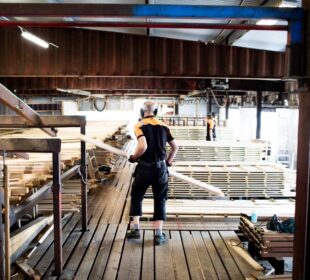The size of the global wooden furniture market is expected to grow from $395 billion in 2018 to more than $580 billion in 2025 (a 32% rise). The growing demand for modular and minimalist wooden furniture in urban and rural areas around the world is expected to drive the development of the wooden furniture market. Consumers' preference for purchasing these products through e-commerce channels will continue to rise, as e-commerce channels can offer advantages such as customization options, higher discounts, and faster delivery speeds, which will drive the industry's expansion. In addition, the increasing popularity of luxury wooden furniture for home and office interior design will provide potential growth opportunities for industry expansion.
The growing global real estate investment has led to an increase in the number of commercial complexes, residential buildings and office space, stimulating demand for wooden furniture products. In addition, the ever-increasing disposable income and rising living standards, as well as the increase in the number of core households, strongly support the needs of the wooden furniture industry. In addition, the demand for an efficient and comfortable working environment in modern office interiors is increasing, which will expand the size of the wooden furniture market.
As the public's growing concern about global warming has led to increased consumer demand for environmentally friendly furniture, wood furniture manufacturers are able to develop products using sustainable, eco-friendly materials. In addition, wooden furniture manufacturers are increasingly focusing on providing eco-friendly and adaptable products to gain market competitive advantage. For example, in September 2014, Greenington, LLC announced the launch of a new compact outdoor furniture division that uses 100% environmentally friendly solid bamboo to meet the growing demand for environmentally friendly products.
By 2025, modern work and life concepts, such as learning rooms for children, adolescents and students, are in desperate need of cutting-edge modular furniture to create a better learning atmosphere. For example, in March 2017, Microsoft announced a partnership with Steelcase, the global leader in the office furniture industry, to develop technically supported workplace solutions by upgrading Microsoft architecture and furniture, which will help increase employee creativity. In addition, increasing investment in the construction and renovation of new hotels, educational institutions, hospitals and office buildings will have a positive impact on market growth.
More and more people are eager to choose compact and portable furniture for optimal space utilization, which strongly supports the needs of the wooden furniture industry. Industry players have been working to improve their product portfolio and upgrade their solutions to gain competitive advantage and increase their market share.
In 2018, the residential sector accounted for more than 65% of the wooden furniture market. More and more consumers are eager to purchase high-end wooden furniture and home furnishing products that are uniquely designed and beautiful, thus increasing the demand for products in residential buildings. In addition, favorable government housing plans and policies, as well as an increase in the number of single-family homes seeking basic living arrangements such as bedrooms and kitchens, are expected to further guide the needs of the wooden furniture industry.
The global market share of wooden furniture is highly fragmented, with large regional companies and multinational companies. These wooden furniture manufacturers participate in mergers and acquisitions, product innovation, strategic investment, new product launches and the use of online distribution platforms and capacity expansion to gain a competitive market share in wooden furniture. For example, in 2018, North American well-known wooden furniture company Dorel home acquired British furniture company Alphason to expand its product portfolio and business in the European wooden furniture market.
According to a report by Global Market Analysis Corporation in 2019, the average annual compound growth rate of the North American wooden furniture market will exceed 5.5% from 2019 to 2025. Due to the high growth of the real estate industry, the region's growing demand for modular furniture and simple wooden furniture has increased the share of the wooden furniture industry. The emergence of major manufacturers of luxury interior products and the high availability of convenient and time-saving online distribution channels will drive the growth of wooden furniture products in North America. For example, in April 2017, Ethan Allen (famous international furniture manufacturer and retailer) partnered with Amazon to leverage Amazon's online sales platform to gain a larger consumer base and expand its sales.
In 2018, the wooden furniture market in the Asia-Pacific region dominated, accounting for more than 45% of the industry. Factors such as increased disposable income, rapid urbanization, and improved living standards are key factors in stimulating product growth in the region. The rapid growth of the tourism and hospitality industries, as well as the high preference for traditional wooden furniture, will further promote the growth of the wooden furniture market in the Asia Pacific region.

















